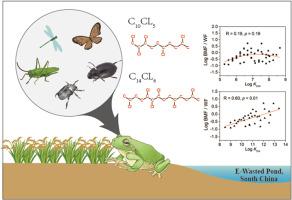华南电子垃圾影响生态系统中两栖动物氯代石蜡的生物放大效应:定量脂肪酸特征分析的证据
IF 7.3
2区 环境科学与生态学
Q1 ENVIRONMENTAL SCIENCES
引用次数: 0
摘要
两栖动物是具有重要生态意义和环境敏感性的脊椎动物,但氯化石蜡在两栖动物体内的生物积累行为和营养转移尚不清楚。在本研究中,我们检测了来自电子垃圾污染湿地的两栖动物及其昆虫猎物中短链和中链氯化石蜡(S/MCCPs)的浓度、组织分布和同系物特征。采用定量脂肪酸特征分析(Quantitative fatty acid signature analysis, QFASA)确定两栖动物的膳食组成,并改进生物放大因子(BMFQFASA)的计算方法。两栖动物组织中总CPs的中位浓度范围为1.75 ~ 38.2 μg/g脂质重(lw), 8种昆虫组织中总CPs的中位浓度范围为1.45 ~ 7.14 μg/g lw。结果表明,S/MCCPs在两栖动物组织中分布广泛,SCCPs在皮肤中含量最高,MCCPs在肌肉中含量最高。捕食者-猎物关系和生理性状影响了三种两栖动物的组织特异性积累和种间差异。主成分分析显示CP同源谱的聚类模式反映了营养转移,特别是在两栖动物和昆虫类群(如蜻蜓)之间。S/MCCP同系物的BMFs范围分别为0.55 ~ 11.7、0.12 ~ 5.27和0.26 ~ 6.49,除WF食物链中的sccp外,其余均呈现生物放大效应。对数BMFQFASA与对数KOW呈抛物线关系,与对数KOA呈强正相关,表明KOA能较好地预测两栖动物的生物放大率。我们的研究结果为两栖动物食物链中CPs的环境行为提供了新的见解,并强调了在生态风险评估中考虑物种特异性特征和物理化学特性的必要性。本文章由计算机程序翻译,如有差异,请以英文原文为准。

Biomagnification of chlorinated paraffins in amphibians from an e-waste effected ecosystem, South China: evidence from quantitative fatty acid signature analysis
Amphibians are ecologically significant and environmentally sensitive vertebrates, yet the bioaccumulation behavior and trophic transfer of chlorinated paraffins (CPs) in amphibian remain poorly understood. In this study, we examined the concentrations, tissue distribution, and congener profiles of short- and medium-chain chlorinated paraffins (S/MCCPs) in amphibians and their insect prey from an e-waste-contaminated wetland. Quantitative fatty acid signature analysis (QFASA) was applied to determine amphibians’ dietary composition and to refine biomagnification factor (BMFQFASA) calculations. Median concentrations of the total CPs were ranged from 1.75 to 38.2 μg/g lipid weight (lw) in amphibian tissues, and ranged from 1.45 to 7.14 μg/g lw in eight insect species. Results showed that S/MCCPs were widely distributed in amphibian tissues, with the highest SCCPs levels found in skin, and MCCPs in muscle. Predator–prey relationships and physiological traits influenced tissue-specific accumulation and interspecies differences in three amphibians. Principal component analysis of CP homologue profiles revealed clustering patterns reflecting trophic transfer, particularly between amphibians and insect taxa such as dragonflies. BMFs of S/MCCP congeners ranged from 0.55 to 11.7, 0.12 to 5.27, and 0.26 to 6.49, respectively, exhibited biomagnification along the amphibian food chains, except for SCCPs in the WF food chain. Log BMFQFASA showed a parabolic relationship with log KOW and a strong positive correlation with log KOA, suggesting that KOA is a better predictor of biomagnification in amphibians. Our findings provide novel insights into the environmental behavior of CPs in amphibian food chains and highlight the need to consider species-specific traits and physicochemical properties in ecological risk assessments.
求助全文
通过发布文献求助,成功后即可免费获取论文全文。
去求助
来源期刊

Environmental Pollution
环境科学-环境科学
CiteScore
16.00
自引率
6.70%
发文量
2082
审稿时长
2.9 months
期刊介绍:
Environmental Pollution is an international peer-reviewed journal that publishes high-quality research papers and review articles covering all aspects of environmental pollution and its impacts on ecosystems and human health.
Subject areas include, but are not limited to:
• Sources and occurrences of pollutants that are clearly defined and measured in environmental compartments, food and food-related items, and human bodies;
• Interlinks between contaminant exposure and biological, ecological, and human health effects, including those of climate change;
• Contaminants of emerging concerns (including but not limited to antibiotic resistant microorganisms or genes, microplastics/nanoplastics, electronic wastes, light, and noise) and/or their biological, ecological, or human health effects;
• Laboratory and field studies on the remediation/mitigation of environmental pollution via new techniques and with clear links to biological, ecological, or human health effects;
• Modeling of pollution processes, patterns, or trends that is of clear environmental and/or human health interest;
• New techniques that measure and examine environmental occurrences, transport, behavior, and effects of pollutants within the environment or the laboratory, provided that they can be clearly used to address problems within regional or global environmental compartments.
 求助内容:
求助内容: 应助结果提醒方式:
应助结果提醒方式:


